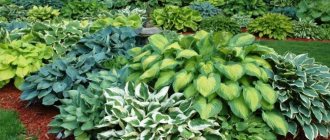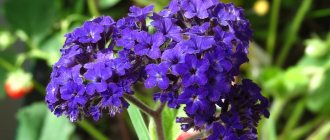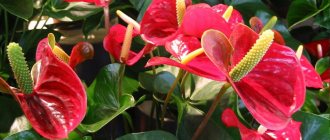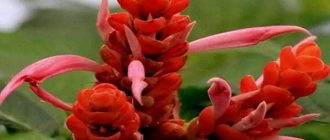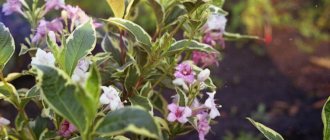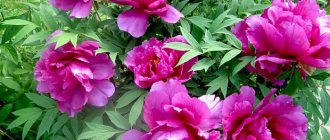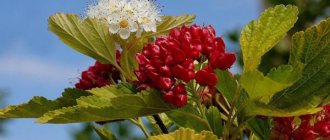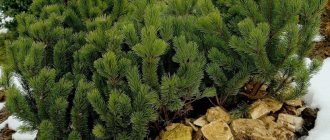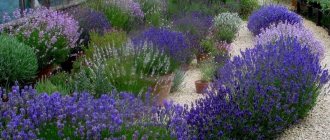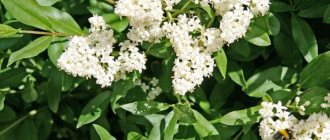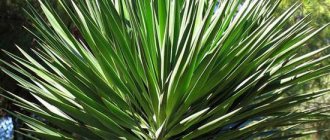Lavender is a very famous perennial evergreen plant, captivating with its elegance, beauty, and delicate aroma. In addition to its beautiful appearance, lavender is used in various industries and in everyday life. Many countries have long been suppliers of lavender; it is grown on an industrial scale. In the French province of Provence, lavender is a hallmark, where 80% of the plant used in the world is grown.
Lavender essential oil has long been used to treat many ailments. And lavender tea is an ancient cure for headaches. The uses of lavender oil are very wide. Due to its numerous beneficial properties, the plant is used in the treatment of various ailments.
Due to the fact that the perennial is a heat-loving plant, unable to survive the cold period of the year in the middle zone, breeders have adapted many varieties for the Russian climate. Lavender can now be grown in areas with cold winters, making it a great addition to many gardens.
Description of the plant
Lavender is a perennial spicy medicinal herbaceous plant, subshrub, shrub of the Lamiaceae family.
In its natural environment, lavender grows on the Mediterranean coast, on the Canary Islands, in southern Europe, in India and Arabia, in northeast Africa. On the territory of Russia they are found on the Black Sea coast of the Caucasus. Many species and varieties are adapted to areas with different climates.
The root system is powerful, taprooted, woody. The stems are branched, spreading, erect, tetrahedral. The leaves are elongated, narrow, linear, oblong, with a whole or serrated edge, opposite, sessile, with curled edges.
In nature, lavender flowers are blue or purple; many varieties have more varied colors. Tall thin peduncles rise above the bush, at the end of which 6 - 10 flowers are collected in false whorls and form spike-shaped inflorescences. The plant blooms in the second half of summer. After flowering, lavender seeds are formed - a dense, dry, oval-shaped seed of a dark brown color.
The spicy, tart smell of lavender makes this plant in demand in the perfume and cosmetics industry. Lavender essential oil has good medicinal properties and is used for various ailments. Many people grow lavender in open ground not only as a garden decoration or as a raw material on an industrial scale, but also as a medicinal herb.
When does lavender bloom?
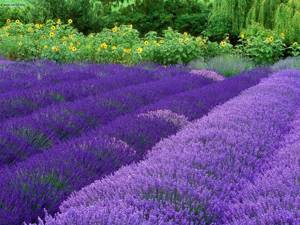
To ensure abundant bright flowering, it is necessary to follow a number of rules for caring for the bush. Lavender shows its flower at the beginning of summer and until autumn. At the moment when lavender blooms, the bush is covered with bright flowers, becoming like a “fluffy” balloon. When planted in groups, flowering plants create an amazing and spectacular appearance of an elegant “bedspread,” and the delicately spicy aroma from the flowers fills the garden space for a long time. Every year, from spring until autumn, the perennial is able to decorate the flower garden. Since ancient times, the magnificent characteristics of lavender have been appreciated.
Types and varieties
Lavender is a plant that needs no introduction. Many gardeners enjoy growing these beautiful bushes, which, in addition to their wonderful elegant aroma and delicate flowers, have medicinal properties.
The genus has approximately 25 - 30 species, but only two of them are cultivated: angustifolia and broadleaf lavender. Many varieties of lavender were obtained precisely from them. Thus, the “butterfly” lavender variety has the most pronounced aroma. Many species are found only in warm areas, such as multicut lavender, which is not grown in Russia. For central Russia, only the narrow-leaved species is suitable, since it is able to survive harsh winters; other species are more heat-loving.
The wide use of the plant makes it truly unique.
Serrated
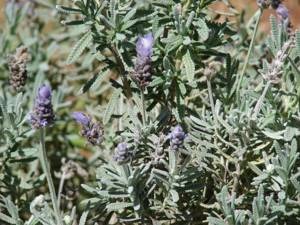
Lavender serrated
The height of the perennial shrub is no more than 1 m, the width is up to 1 - 1.5 m.
The leaves are elongated, up to 4 cm long, oblong. The variety got its name due to the characteristic serrated edge of the leaf.
Serrated lavender blooms from June with violet-blue flowers collected in a capitate inflorescence at the ends of the stem. A fairly heat-loving species, it will not survive the cold season without shelter; it can withstand temperatures down to -15 C. It prefers open sunny areas with well-drained calcareous soil.
Broadleaf
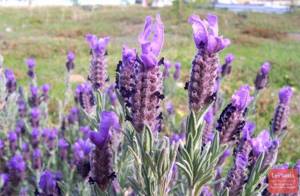
French lavender
Another name is French lavender. It is the most sought after species among flower growers. An evergreen subshrub up to 1 - 1.3 m high. The plant is very fragrant, but the aroma is not as refined as that of angustifolia lavender. Spike-shaped inflorescences are loose, up to 10 cm long. The color of the flowers is very diverse, there are blue, white, indigo, pink, and lilac flowers. Broadleaf lavender blooms earlier than other representatives of the genus: the flowering period is April - June; a second wave of flowering may occur in early autumn. It is a drought-resistant species, able to survive frosts down to -16 C, and requires additional shelter for the winter.
French lavender is considered the ancestor of decorative varieties.
English
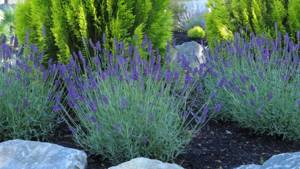
English lavender
The height and width of the bush is up to 1 m. The leaves are narrow, dense, lanceolate, small, gray-green in color, with slight pubescence. A more frost-resistant plant compared to the broad-leaved species. During flowering in July - August, English lavender is covered with small flowers of blue, blue, lilac shades, collected in 6-10 pieces at the tops of the stems in spicate inflorescences. The fragrant aroma is very spicy and pleasant.
Multi-notch
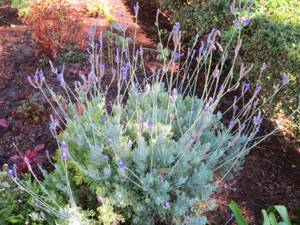
Lavender multicut
It is a perennial herbaceous shrub native to the Mediterranean. It does not winter in central Russia; it is used in cultivation as an annual plant. Fern-like openwork leaves of gray-green color. The flowers are on long peduncles 40–60 cm high, collected in spike-shaped inflorescences of blue-violet color. Multicut lavender forms the first flowers 1.5 - 2 months after the seeds germinate. The bush continues to bloom throughout the season until late autumn. Multicut lavender is quite unpretentious in care.
Narrow-leaved
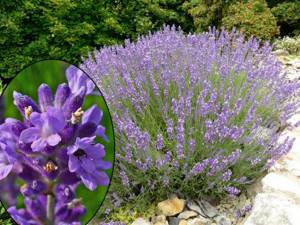
Lavender angustifolia
Other names are English true, lavender officinalis, spicata, true, lavender angustifolia. An evergreen and highly branched subshrub, grows up to 60 - 100 cm in height. As it grows, it forms a spherical crown up to 1 m wide. The leaves are opposite, sessile, narrow, large, linear, about 2 - 6 cm in length and up to 6 mm in width, oblong, gray-green, entire, rolled edges. Lavender angustifolia blooms with fragrant, fragrant flowers throughout the month, usually from July to September. It is a fairly cold-resistant species, can withstand down to -20 C, but requires shelter in snowless winters.
The root system is taprooted, woody, branched in the upper part. Flowers are up to 1 cm in length, collected in false whorls of 6 - 10 pieces. They form loose or dense, intermittent racemose inflorescences up to 4 - 8 cm in length, mainly in blue and purple shades. The peduncles are tetrahedral, the upper internodes are long, up to 30 - 45 cm. They can live in one place for up to 20 years. Prefers open sunny areas, raised above the soil level, and easily gets along in urban environments.
Species diversity
More than 20 varieties of lavender are known, but the following varieties are usually grown on private farms:
lavender angustifolia (English, true) reaches up to a meter in height and a diameter of about a meter; leaves are small, narrow, gray-green; blooms from June to July; easy to care for and relatively resistant to cold,
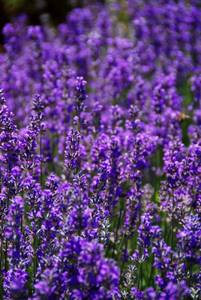
There are many types of lavender, but only a few have beneficial properties.
broadleaf lavender (French) is the ancestor of decorative varieties; the flowers have long bracts and a variety of colors; blooms from May; has a strong and not the most pleasant aroma,
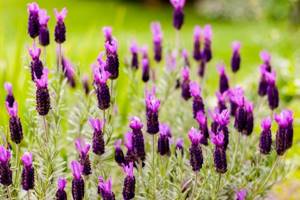
French lavender
Dutch lavender (hybrid) is grown on an industrial scale; reaches a height of two meters; has large inflorescences on long stems; blooms from July; less frost-resistant than narrow-leaved lavender,
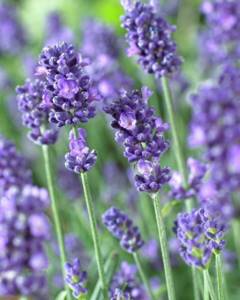
The ancient Romans extracted essential oils from lavender and used them as perfume.
Lavender serrata is a heat-loving variety; leaves are silvery, soft; the flowers are large, in different shades of blue; In the traditional climate of the middle zone, jagged lavender is grown at home, and not outside.
Advice! Any lavender in open ground may not withstand too cold a climate, and therefore it makes sense in the northern regions to plant bushes in pots or flowerpots, and at the slightest cold snap, bring them to a warm place. Lavender in a pot is more difficult to care for than in open ground, and even if all the requirements are met, the plant indoors will bloom less and less often.
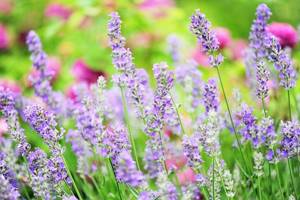
Until 1952, lavender was collected from the fields by hand.
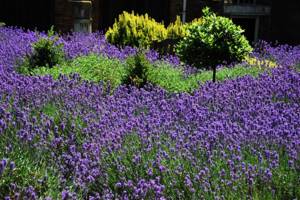
Lavender is an unchanging symbol of French Provence
Plant care
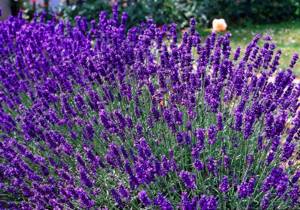
The bush itself can easily do without special care, although in this case the shape of the plant and its decorative effect will suffer. Flower growers identify several basic rules for the care and maintenance of bushes. If you do everything correctly, the plant will be voluminous, retain its spherical shape, and will delight you with its bright blooms every year.
Caring for lavender involves periodically loosening the soil around the stem to ensure constant air circulation in the root zone of the plant and get rid of weeds. Water as the soil dries out. In hot, dry weather, watering is increased, since the lack of moisture reduces and shortens the flowering time. On the other hand, excessive watering creates stagnation of moisture in the soil, which can cause rotting of the roots and yellowing of the stem.
In order for blooming lavender to reveal its full potential, it is necessary to plant it in the most open, sunny areas of the garden. In shady areas the plant develops quite well, but the decorative properties of the plant may suffer and there will be no lush flowering.
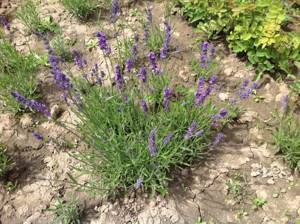
To enrich the soil with additional nutrients, the soil under the bush is covered with rotted leaves and compost. Care should be taken to ensure that the soil around the trunk remains open, otherwise the roots may rot.
When preparing lavender for winter in the fall, the bush is pruned, leaving 10 - 15 cm above ground level. During cold periods, the flower requires additional shelter; in severe frosts and winters with little snow, the bush may die. Gardeners recommend planting lavender in large pots or containers; in the fall it is easier to move them to a warm room for the winter, and caring for lavender in a pot is easier and more convenient.
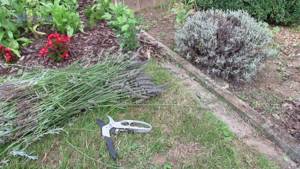
Periodic pruning of the bush is necessary to give the plant the desired shape. Without pruning, the bushes will become elongated, have few branches and will have few flowers.
Fertilizer application
To maintain growth and lush flowering, the bush needs complex mineral fertilizer, which can be purchased at any gardening store. Fertilizers are diluted according to the instructions and introduced into the soil before flowering begins. To enhance the growth and development of green mass, the plant needs nitrogen fertilizer, which is added at the beginning of the bush’s growth in the spring. Under the influence of nitrogen, development processes are stimulated, so they are applied only once. If you re-apply in the summer, the growth of the bush will increase; it will not have time to prepare for the winter period of the year.
Many gardeners, instead of applying fertilizer, cover the soil under the bush with a thick layer of compost mulch. Thanks to this, the plant receives nutrients throughout the season.
Trimming
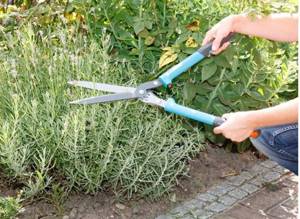
Only proper pruning of lavender can form a neat, beautiful bush, otherwise the plant will stretch out and take on an ugly shape with a bare lower part and sparse gray leaves.
In April, when young shoots 15–20 cm high are planted in open ground, randomly located shoots are cut off to stimulate the growth of the bush. After this, the bush is left alone for a year, and next spring, last year’s dry inflorescences are cut from the bush.
If the bush is healthy and well-groomed, spring pruning to 15 cm above the ground is allowed, which in turn will help the plant reproduce young shoots. This will affect the maintenance of the decorative appearance. It is not recommended to trim the bush below 10 - 15 cm, as this may cause the death of the plant.
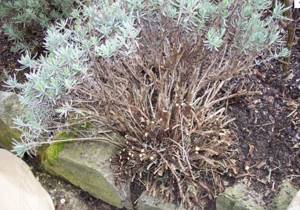
The main rule of pruning with proper care is not to cut off too much. It is better to remove as little as possible than to overdo it and ruin the bush. It is better to trim lavender flower stalks in the spring, and not in the fall, as many people do. Faded inflorescences help the bush survive the winter period.
Many people make the mistake of pruning the bush immediately after flowering; as a result, the flower forms new shoots that can suffer with the onset of cold weather.
Rules for planting lavender with seeds and rhizomes
Seeds should be planted in open ground before winter. They are sealed to a depth of 3-4 cm after all pre-planting work has been completed. However, more often the seeds are germinated, like most perennials, in early spring in seedling boxes. The emerging sprouts are first planted in separate containers, and then, with the onset of summer, they are planted on permanent beds. However, plants planted in this way bloom after 2 years.
Planting with rhizomes (seedlings) is more effective. The holes are dug in May, every 80–90 cm. The rhizomes are buried to a depth of 20 cm, then the soil is compacted and watered. During the first season, moisten the soil so that it is slightly damp to the touch. The top layer is regularly loosened. The next year, in the spring, the bushes are shortened by 1/3. Before pruning, the pruning shear blades are wiped with alcohol. Watering is sharply reduced or even stopped: drought is less destructive for plants. The main thing is that the soil remains loose and clean - without weeds.
Diseases and pests
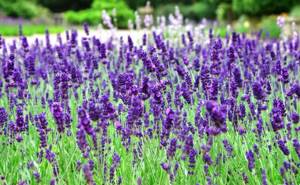
The lavender plant is quite resistant to diseases and pest attacks. The appearance of pests and diseases occur due to improper care. Due to diseases, the bush is exposed to gray rot. This fungal disease is expressed in the formation of gray-brown spots on the stem and the appearance of a gray fluffy coating. Rot leads to the death of leaves, flowers, fruits, and with severe infection the plant can die completely.
Affected areas of the plant are cut off and burned as far as possible from the planting sites. The bush is treated with 1% Bordeaux mixture; in extreme cases, the use of a fungicide is allowed. The occurrence of gray rot indicates a violation of the rules of care. First of all, it is necessary to reconsider the watering regime; most likely the soil is very waterlogged and there is stagnation of water.
Among the pests, the plant is attacked by pennies, which spoil the decorative appearance of the bush by eating large holes in the leaf blades. The insect is collected by hand, and the affected leaves are removed from the bush. The pennitsa lays eggs on the stem, covering them with foam, which is easily washed off with water. The jagged appearance can be spoiled by the rainbow beetle, which eats the leaves of the bush. The insect is collected by hand from the plant.
Planting and propagation
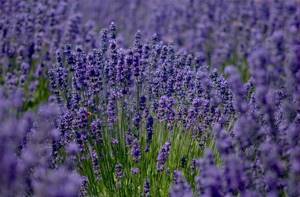
Of all the types of lavender in central Russia, only angustifolia lavender can survive in open ground, and only if there is good shelter for the winter. Lavender propagation occurs in three ways: seed and vegetative methods, using cuttings, dividing the bush and layering. Stratification of lavender seeds is a mandatory process before planting. Growing lavender from seeds is a rather labor-intensive process, as a result of which it is rarely used.
Lavender is often used at home for interior decoration, as drawings and images on dishes, furniture, textiles, and in flower arrangements.
In the southern regions, various varieties of lavender are grown at home and in greenhouses. Some varieties, for example, multicut lavender, which is extremely heat-loving, can now be grown in any climate zone.
How to plant lavender?
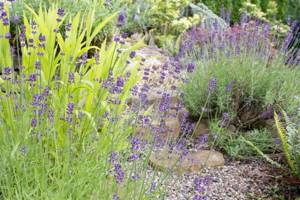
When choosing young bushes ready for planting in specialized stores, you should choose varieties adapted to the local climatic zone. Experienced flower growers advise planting lavender on the site in early spring, when night frosts have stopped. Planting in the fall is possible, but only for the southern regions and no later than 2 months before the onset of cold weather.
Immediately before planting, the bush is immersed in cold water for 1-1.5 hours.
Since the plant loves elevation, before planting lavender, it is necessary to make beds at a height of 20 - 40 cm above ground level, or on a hill.
To stimulate young bushes to grow and branch, their upper part is cut off before planting. Overgrown roots and lower leafy branches are removed. For seedlings, prepare a hole 20 - 30 cm deep. The distance between plants should be equal to the height of an adult bush. To create denser plantings, the distance between seedlings is reduced.
Lavender seeds remain viable for many years, provided they are properly stored. After ripening, they are collected and sealed in a dry, airtight container. In mid-autumn, you can sow lavender seeds directly into open ground without prior stratification.
How to grow lavender in the country?
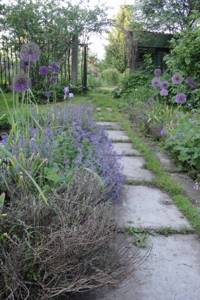
First of all, you need to choose a place for planting: it should be open and protected from the wind. In shady places it will not be possible to achieve bright, rich flowering.
How to grow lavender at the dacha so that it does not freeze in winter and delights with its presence for many years? For residents of cold climate zones, flower growers advise planting bushes not in open ground, but in large flowerpots, which are brought indoors with the onset of cold weather.
When planting lavender in open ground, you should follow the watering regime: waterlogging of the soil is extremely dangerous, it will lead to the death of the plant.
How to grow lavender in the country so that it realizes its full potential? One of the main conditions for care is to apply fertilizing in a timely manner, which will stimulate the bush to rapid growth of green mass, abundant and long-lasting flowering.
To create a neat lawn, border, flower bed, edging of a flower bed, hedge and alpine hill, you should form the crown of the bush, otherwise it will take an indefinite shape.
When growing lavender seedlings, flowering should not be expected until next year.
Seeds for seedlings are planted in late February - early March in small containers with soil. Seeds are sown in shallow holes at a distance of 2 - 3 cm from each other. Cover the container with a transparent lid, provide constant lighting, periodic watering, and a temperature of +15...+21 C. Under such conditions, the seeds will germinate in 1.5 - 2 weeks. During this time, it is necessary to ventilate the containers daily. As soon as the shoots appear, the ventilation time is increased. Grown sprouts are planted in separate pots or flowerpots at a distance of 5 cm from each other.
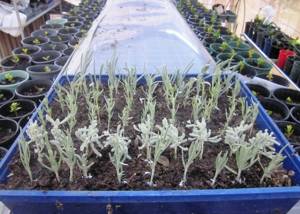
Young shoots tolerate transplantation well. In May, such sprouts are planted in a permanent place in open ground.
How to grow lavender at home?
To grow lavender at home, you need to select a container with holes in the bottom to remove excess moisture. A pot with a diameter of 25 - 30 cm and a volume of up to 2 liters is suitable. The bush will grow to its full size in about 3 - 5 years. During this time, the bush is annually transplanted into larger pots.
The flower must be provided with the ability to quickly and efficiently drain excess water. To do this, a drainage layer is placed at the bottom of the container: you can use any suitable material, for example, expanded clay, pebbles, broken bricks, nut shells, shards. Make sure that the drainage does not cover the drain holes.
Before you try to grow lavender at home, you should create the right environment for it. The soil should consist of a mixture of sand and peat; it would be useful to add crushed eggshells to the soil. Before planting lavender seeds in pots at home, they are subjected to stratification.
The main task when caring for lavender at home is to ensure proper periodic watering, the required level of air humidity, and as much sunlight and heat as possible. Water young seedlings daily in the morning or evening throughout the growing season. The water should be at room temperature, settled. The soil should be slightly moist; excessive watering can ruin the plant. The bush really likes it when water gets on the green parts of the plant when watering.
To stimulate growth during the first 2 - 3 months, young bushes are fed weekly with liquid fertilizer (2 grams per 1 liter of water). A good level of humidity can be maintained with an electric humidifier or by manually spraying cold water around the flower pot. Light-loving lavender requires a lot of light, so it is better to give it a place on the windowsill on the south side. Young shoots should be provided with conditions so that they are exposed to lighting for at least 10 hours a day; in extreme cases, phytolamps can be used. With the onset of spring, you should take the pot with the plant out into the open air for a couple of hours a day, each time slightly increasing the “walk” time.
Since the flower overwinters indoors, the bush is pruned after the flower stalks have dried. In winter, the flower needs rest. At this time, watering is reduced, and the pot itself is placed in a cooler place. If the container with the plant is on the windowsill, you should take care that the heat from the central heating radiator does not dry out the soil. If the lavender did not rest in winter, but began to grow, with the arrival of spring, the growths that have grown over the winter must be cut off.
How to plant lavender with seeds?
Before sowing lavender seeds, they must be subjected to pre-treatment - stratification. For proper stratification, the seeds are poured into a pot with wet sand, covered with a lid and put in the cold, kept for 1.5 - 2 months at a temperature of +5 C. Lavender is planted twice a year - in early spring and mid-autumn.
In October, the collected lavender seeds are sown in the ground and sprinkled with a layer of earth up to 4 mm high. If the soil is dry, then the bed needs to be moistened. In winter, the planting site is covered with a large layer of snow, thereby causing natural stratification. After lavender seeds are planted in the ground before winter, the first shoots can be expected no earlier than May, in some cases even later, when the night frosts have passed.
For spring planting, seeds previously kept in the cold are used. To grow lavender from seeds at home, prepare a container with loose, drained peat soil and sow the seeds. If after 2 - 3 weeks the seedlings have not appeared, the pot with the seeds is placed in the refrigerator for one month for re-stratification. In May, as soon as the night temperature does not drop below -5...-7 C, the seeds are sown in open ground at a distance of 1.5 - 2 cm from each other.
Cuttings
Propagating bushes from cuttings is quite simple. For this purpose, lignified annual shoots are suitable, which are divided into 10 cm, rooted in moist soil by 2 - 7 cm, covered with a transparent cap and watered regularly. The ambient temperature should be within +15...+20 C, good lighting and sufficiently humid air are necessary. When warm weather sets in, lavender cuttings are opened, after which they take root and grow very quickly.
You can quickly propagate the bush using layering. To do this, in the spring, 2-3 branches are pressed to the ground, deepened into holes up to 5 cm high, fixed with brackets and covered with soil. After some time, the branch will take root. Separate the new bush from the mother one in the fall, after pruning.
The propagation method by dividing the bush is as follows. Before preparing for winter, the bush is pruned, leaving 10 - 15 cm above ground level, carefully hilled up, densely covering the bushes with earth. In summer, the bush grows well and produces a lot of young shoots that take root well. At the end of the season, the bush is dug up, divided, cutting with a knife, then the divisions are planted in new places.
Preparing for winter
Some types of lavender are considered frost-resistant. They are able to withstand temperatures down to -25 C. However, experienced gardeners in any case advise covering the bushes for cold weather. Preparing lavender for winter begins at the end of the season, after low pruning of the bushes, on which tree branches are laid. The most suitable branches of coniferous trees for these purposes. You should not fill the beds with fallen leaves; the bushes under them may begin to rot and rot.
Botanical description of Lavender serratus
It just so happens that of all the existing types and varieties of lavender, our summer residents prefer to grow narrow-leaved and stekhadskaya, which appears in many sources under the name “French”. However, the “new product”, which settled in Ukrainian flower beds and country front gardens relatively recently, is in no way inferior to its more famous sisters - neither in beauty nor in the aroma that it exudes.
Dossier
- The leaves are about 40 mm long; belong to the serrated type, for which lavender received its name; rugged;
- inflorescences of capitate type;
- flowers are miniature, painted purple;
- bracts large purple;
Lavender serrata begins to exude an incomparable aroma in the middle of the summer season: its flowering begins closer to the second half of July.
Serrated lavender can reach a height of 100 cm. The width of the bush is often even greater than the height - up to 150 cm. From a distance, it seems that the bush is painted in a silvery tint. This is the effect that pubescence gives to a plant. In its natural environment, this fragrant representative of the flora lives in the following regions of our planet:
- Arabian Peninsula;
- southern part of the Mediterranean coast;
- Antilles (aka Caribbean Islands).
There are several varieties of jagged lavender, but only one is particularly popular among gardeners - the Royal Crown variety. It, unlike its fellows, has bracts and flowers of a rich purple hue. The variety is so good that it was awarded the highest award - the Award of Garden Merit, which is awarded annually by the English Royal Horticultural Society.
Features of caring for lavender serrata
If you dream of lavender bushes blooming profusely and densely on your site, start by wisely selecting a location for planting them. Serrated lavender will bloom most luxuriantly where the area is open and not shaded. The plant will also develop in partial shade, but it will not pamper you with an abundance of flowering branches.
- The soil. Serrated lavender likes neutral, porous soil. Places with high groundwater levels are absolutely not suitable for it. If you are not sure that the soil at your disposal is suitable for lavender, add wood ash to it. This is one of the most effective and affordable deoxidizers that will normalize the pH of the soil.
- Feeding. You can feed lavender with various fertilizers, including mineral ones. However, the main feeding is still compost. Firstly, it saturates the soil with the nutrients necessary for lavender, and secondly, it makes the soil more porous and loose.
- Trimming. It is extremely important, after the Mediterranean bushes have finished flowering, to eliminate all flower stalks from them. This pruning is rejuvenating. If this is not done, every year the flowers will become smaller and less lush.
- Wintering. Serrata lavender thrives outdoors as long as the temperature does not drop below 5° degrees. If you want to preserve a plant that is growing in a container, simply bring it indoors and let it overwinter there. Container lavender will not cause you much trouble.
- Transfer. Serrata lavender, like other representatives of this genus, is transplanted with a large earthen lump. If you are organizing a flower bed and want to achieve maximum lushness of the bushes, you should maintain a distance of 100 cm between them. If you are planting a crop to create a hedge, this distance should be reduced exactly by half.
- Reproduction. The most convenient way to propagate the “novelty” is to bury its petioles. To do this, fill the container with moist soil, “plant” the petioles and cover the container with cling film on top. Once every two to three days, the film needs to be removed and the planting material watered. As soon as the cuttings have roots, and this will happen quite quickly, they can be safely transplanted into open ground.
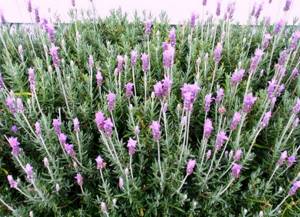
Lavender in the interior
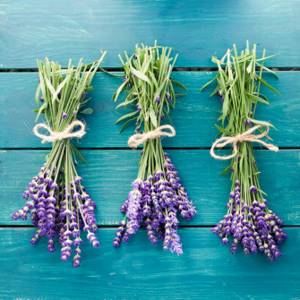
You don't have to have a garden to grow lavender. It will decorate and delight any home with its appearance and aroma. A bouquet of dry lavender will fit perfectly into any bedroom, ensuring a serene, restful sleep, and will also fill the room with the subtle aroma of summer. Lavender will add a lively touch to the interior, because in the apartment a pot of lavender looks like a small green island.
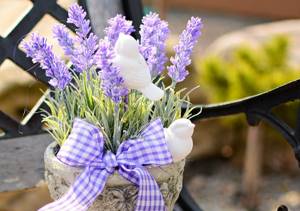
In many cultures, the lavender flower is considered a symbol of beauty, tenderness, love and sophistication. In addition to the bouquet and flower pots, the interior is often decorated with fragrant linen bags with crushed fragrant herbs inside. Such sachets emit a pleasant floral aroma and are often used by housewives to scent rooms and cabinets. Many people decorate the room with a lavender wreath of dried flowers. Various accessories with the image of a lilac flower, be it furniture or textiles, look harmonious in any interior.
Lavender propagation in autumn
Lavender is very easy to propagate. There are several ways to do this.
Propagation of lavender by seeds
Lavender reproduces well by self-sowing. If you leave a couple of flowers on the bush, the seeds will fall nearby and overwinter. And in the spring you will find small sprouts under your bush. This is how it happens in nature.
And the easiest way for summer residents to propagate lavender is by seeds, sowing it before winter. Read our article on how to properly sow flowers before winter, including lavender.
Reproduction of lavender by layering
My favorite way to propagate lavender is through layering. And now is a great time for this. Before pruning the bush, I inspect it and select several convenient branches for layering. It’s just that if you cut it first, the branches will become short and it will be inconvenient to work with them.
It is better to take thin branches, not branched, and not yet very lignified. I tilt the lavender branch to the ground, pin it either with wire pins so that it lies tightly, or, if there is no wire at hand, then with stones, which is less convenient. I sprinkle soil on top. And I repeat this with other branches. Instead of wire or stones, you can make “slingshots” from branches. And after that I sprinkle it with compost and mulch with pebbles.
The stones will become an additional load for the cuttings, which will make their contact with the ground more dense. And that's all. In the spring, I simply use pruning shears to separate the young lavender bushes, carefully digging them out. The branches will already form roots, and I will transplant them to a permanent place.
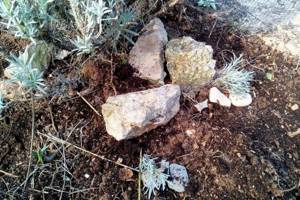
My favorite way to propagate lavender is through layering. © Olga Olshanskaya
Cuttings of lavender in autumn
Lavender propagates well from cuttings. This can be done both in spring and autumn. It is even believed that cuttings take root better in the fall. Therefore, from the branches that I have left after pruning, I select several - 10-15 centimeters in length.
I clear their lower green part of leaves by 3-4 cm. And I simply plant them in the chosen place. You can first make a groove, pour it with water, lay out twigs in it, and then cover it with earth.
It has been noticed that thin branches take root better.
Useful properties and use in folk medicine
Lavender contains essential oils that contain tannins, linalol, coumarins, herniarin, amyl alcohol, citral, bisabolene, cedren, acetic, valeric, butyric, caproic acids. Lavender essential oil is obtained from flowers, since they contain the highest content, about 0.8 - 1.2%. Oil from the inflorescence has anticonvulsant, sedative, diuretic effects, as well as antiseptic and bactericidal properties.
The use of lavender in folk medicine has a wide range of purposes. Flowers are used to treat diseases of the cardiovascular system, nervous disorders, diseases of the digestive tract, kidney diseases and the genitourinary system. The healing properties of lavender are undeniable and have been proven in centuries-old practice; there is no doubt about the beneficial effects on the human body.
In cosmetology, lavender oil is used for hair: its effect literally from the first use gives positive results. Lavender oil for the face is considered an unsurpassed and safe remedy for combating age-related skin changes, skin rashes, and allergies.
Uses of lavender
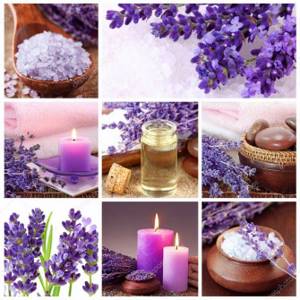
In folk medicine, dried and freshly picked lavender is prescribed for internal and external use. For various infectious diseases, insomnia, various nervous disorders, respiratory diseases, disorders of the gastrointestinal tract, diseases of the female reproductive system and other ailments, infusion and decoction of lavender are prescribed.
Lotions and essential oil are prescribed for various skin diseases, insect and animal bites. Lavender is very useful for hair: it helps restore brittle, damaged hair, and in combination with other methods it helps to cope with scalp diseases. Essential oil is used for massage and rubbing. While bathing, it is useful to add an infusion or a few drops of lavender essential oil to the water.
Plants are also used in everyday life: lavender gets rid of moths. For this purpose, dry twigs are laid out on the shelves of the closet or rag bags with crushed dried flowers are placed. The fragrant spicy aroma also repels insects such as mosquitoes and flies.
Beneficial features
Due to its calming and relaxing properties, lavender tea is recommended for sleep disturbances and nervous exhaustion. Baths and massages using essential oils, as well as aromatherapy, help with headaches and have a mild, hypnotic effect, which helps reduce tension and relieve muscle pain.
Lavender essential oil
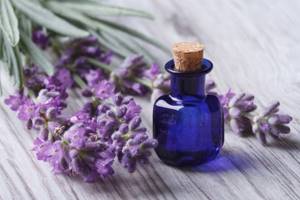
Due to the healing properties of lavender, the use of essential oil based on it has a wide range of applications. In appearance, the oil is almost transparent, with a barely noticeable yellow tint. Thanks to its good compatibility with other essential oils, fragrant, aromatic compositions are created for wide use, both in everyday life and for medicinal purposes. Lavender oil for the face is most often used in cosmetology in the production of masks, creams, gels and other products. The use of lavender essential oil for hair can be a salvation for diseases of the scalp, dandruff, damaged hair structure, hair loss and fragility.
Contraindications
Lavender essential oil is not an allergen, but this does not mean that you should neglect precautions. A sensitivity test must be performed before use. It is not recommended to use essential oil during pregnancy, breastfeeding, or hypotension, as it affects hormonal levels and blood pressure. When taking iron and iodine-containing medications, it is better to avoid essential oils. The smell of lavender is very fragrant and spicy. Not every person can calmly tolerate such a strong aroma; some people feel sick from the thick smell. In this case, the use of essential oil should be discontinued.
Use in cooking

Lavender is truly a versatile plant. In addition to cosmetology, medicine and perfumery, in many countries it is used in cooking. It is added when preparing almost every dish - meat, salads, sauces, desserts, drinks. In Russia, this spicy herb is not used so often in cooking; people mostly drink tea with lavender. It gives the drink a pleasant spicy and fragrant aroma; in addition, this tea is very beneficial for health.
Lavender tea
Lavender tea is considered a universal remedy for maintaining health in the treatment of many ailments. Tea with lavender is drunk for headaches, nervous exhaustion, and excitability. It helps to relax and get rid of insomnia. Many women note a decrease in nausea and pain during menstruation.
Classic lavender tea is prepared from two tablespoons of dried flowers and one glass of boiling water. It is necessary to infuse the drink for 10 - 15 minutes. You should not get carried away with such drinks, otherwise local allergic reactions and indigestion may begin. The daily norm of such tea is no more than 2 - 3 cups per day.
Application in landscape design
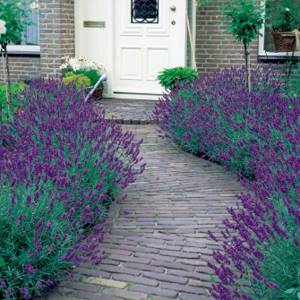
Lavender in the garden has an impressive, compact and neat appearance; it looks good both in mono plantings and in compositions with other garden ornamental plants. In landscape design, lavender is used to create flower beds, rock gardens, rockeries, paths, and hedges. Lavender angustifolia is perfect for edging flower beds and borders. Multicut lavender serves as a good background and frame for flower beds. Several varieties and species can be combined in one color composition, which will give the garden an original and unusual look.

